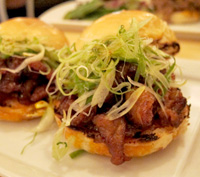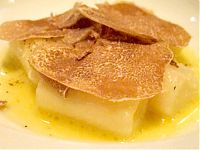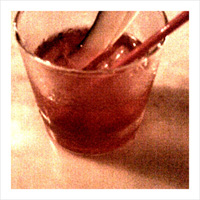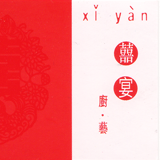


Xi Yan
by Celia Sin-Tien Cheng
January 5, 2006
I’m not sure if you’ve noticed, but there are few reviews of Chinese food in Cravings. This doesn’t mean that I’m not dining at Chinese restaurants, it just means that most of what I’ve tried in New York City is either too disappointing to talk about or not thought-provoking enough for me to write a positive review. Sadly, satisfying Chinese dining experiences are so limited that I either have to go to my friend Shida Kuo’s house for his amazing home cooked meals, or wait until my next trip back to Asia, which could be anywhere from six months to a year.
I recently returned from a visit to Taipei, Hong Kong and Shanghai, where I temporarily satiated my never-ending craving for good, authentic Chinese food. Holding on to every last chance, my sister and I visited our most beloved Shanghainese restaurant in Taipei before boarding the plane, ordered all our favorite dishes and packed our own bento boxes for the flight back. Now don’t tell me that I don’t take my food seriously.
This year, Chinese New Year falls on January 29th according to the lunar calendar. In celebration of the coming year of the dog, I wanted to share with you the best meal I had in 2005. En route to Shanghai from Taipei, my family and I stopped in Hong Kong specifically for this one meal at one of the top speakeasies, Xi Yan.
In the past couple of years, speakeasies — not the speakeasies you think of in the U.S. from prohibition days, but private kitchens run by gourmands rather than seasoned, trained chefs — in Hong Kong have seen a surge in popularity that started out as a fad. These days, they are an essential part of the highly refined culinary culture for sophisticated diners.
Xi Yan is no newcomer to the scene, going on its fifth year since opening, but it certainly has maintained its high quality standards and, with a two-month waitlist, remains one of the most popular speakeasies. Chef owner Jacky Yu is a light-hearted, convivial character with creative sensibilities that are unparalleled. He serves a twelve-course prix-fixe menu for a minimum of six persons per table in a dining room that comfortably seats around forty. There is only one seating each evening.
Formerly in advertising, Jacky always loved to eat and experiment in cooking. So when he decided to pursue his culinary passion full time, he converted his ad agency studio space into Xi Yan. Hence why the speakeasy is so hard to find — it’s on the third floor of a commercial building.
Jacky is doing so well that he has published his own cookbooks and co-hosts a food show on TV. He recently opened another Xi Yan in Singapore and Xi Yan Sweets — an offshoot of Xi Yan devoted to desserts — in the same Wanchai area as the original restaurant in Hong Kong. I’m not sure how he manages everything, but all I want to say is, “Don’t stop!”
The name of the speakeasy, “Xi Yan,” means “banquet” (the first word, “Xi,” refers to joyous occasions such as weddings). The cuisine at Xi Yan is a display of Jacky’s passion for food and art and how he is able to combine the two. With a keen sense of which ingredients can work well together, he seamlessly welds Thai, Chinese (Cantonese and Sichuan amongst other regional styles), Japanese and other Asian cuisines into his culinary art. I refuse to label Jacky’s cooking as “fusion” because there is nothing contrived in his food or spirit. He has an amazing energy and clarity about him. He is skilled at finding the perfect balance in the diverse Asian ingredients he uses to create delicious new dishes based on familiar flavors. He successfully infuses fun into his modern interpretation of Chinese food and the concept of the banquet.
The beauty of it is, while twelve courses seems like a lot, Jacky’s cooking and ensemble of dishes are thoughtfully light and refreshing. Most people think of Chinese food as extremely greasy. That is a misconception. Bad Chinese food is greasy. As with any cuisine, if you can see the grease on your plate, it’s probably unrefined, low quality food. At Xi Yan, twelve courses later, I don’t recall any dish being too heavy.
Of the twelve courses — four starters, seven mains and one dessert — I am highlighting three of my favorites in this feature. Hopefully, that is enough to whet your appetite. I am certainly already trying to plan my next trip to Hong Kong so that I can return to Xi Yan for another strikingly memorable experience.
Xi Yan
by Celia Sin-Tien Cheng
January 5, 2006

GREENHOUSE TOMATOES W/ SESAME DRESSING
The Japanese imported tomatoes used for this starter are temptingly fresh, plump and juicy. The accompanying sesame sauce does not cover the taste of the tomatoes but rather complements and draws out their original flavor. A master of sauces, Jacky makes this one from ground sesame seeds, olive oil, wasabi, egg yolk, vinegar and sugar. A sesame fiend, I think everything tastes better with a little added. Though creamy sesame sauce is a common Japanese salad dressing that I love, the standout ingredient here is wasabi. The subtle mustard kick makes the perfect union. This is a seemingly simple dish, but without the perfect tomatoes and the right dressing, it would not work at all.
Xi Yan
by Celia Sin-Tien Cheng
January 5, 2006

CHICKEN IN HOT & SPICY SAUCE
Xi Yan’s signature, this main is based on a popular Sichuanese cold dish. While the chicken seems to be the central star, the supporting roles of preserved duck eggs, mungbean sheets, roasted sesame seeds, roasted peanuts and Chinese celery are equally important in this masterpiece. Let us not forget that the soy-sauce-based hot and spicy sauce is actually the true star, though it’s easy to overlook. Because at the end of the day, if a sauce is good, anything you dip or serve in it can turn into an outstanding dish. You can request for this dish to be medium or regular spicy. Either way, it’s still very spicy, since Sichuan spice is not the uncomfortable type that burns your tongue. Instead, it warms you up and keeps you coming back for more. The mungbean sheets (similar to wide rice noodles but made of mungbean) and preserved duck eggs are cooling agents to counter the spiciness of the sauce. The peanuts add a crunchy texture in contrast to the smoothness of the chicken. The Chinese celery is diced and seems to be more of a garnish, although its fresh coolness also acts to balance the fire of the dish. It’s pretty amusing that the literal translation of the Chinese name of this dish is “saliva chicken,” but it makes sense to me now as my mouth waters at the mere thought of it.
Xi Yan
by Celia Sin-Tien Cheng
January 5, 2006

GLUTINOUS RICE DUMPLINGS IN GINGER SOUP
While the English names of Chinese dishes often sound outlandish or unappetizing, I’d like to point out that original Chinese names are often poetic, just not translatable because no one would know what’s in them. Glutinous rice dumplings, commonly served as dessert, are filled rice balls, boiled and served in a soup base. The filling used varies, but today’s choice — winter melon candy, preserved duck egg yolk, sesame seeds, and ground peanuts — was out of this world. I’m sure I’m missing an ingredient or two, but it was positively delicious. The soft lavender and white of the dumplings and the tangerine color of the honeydew melon pieces, enveloped by clear, yellow tinted ginger soup, makes a perfect picture that you almost don’t want to touch. But alas, who am I kidding? I devoured it all, so I can tell you, this dish tastes as good as it looks. On a last side note, the Chinese have a saying for everything, and the circularity of these rice balls is significant because it symbolizes “reunion.” I won’t get into the details of this, or I’ll have to teach you the entire language, but suffice it to say that it was a very nice reunion for my family and the perfect ending to a perfect meal.



















